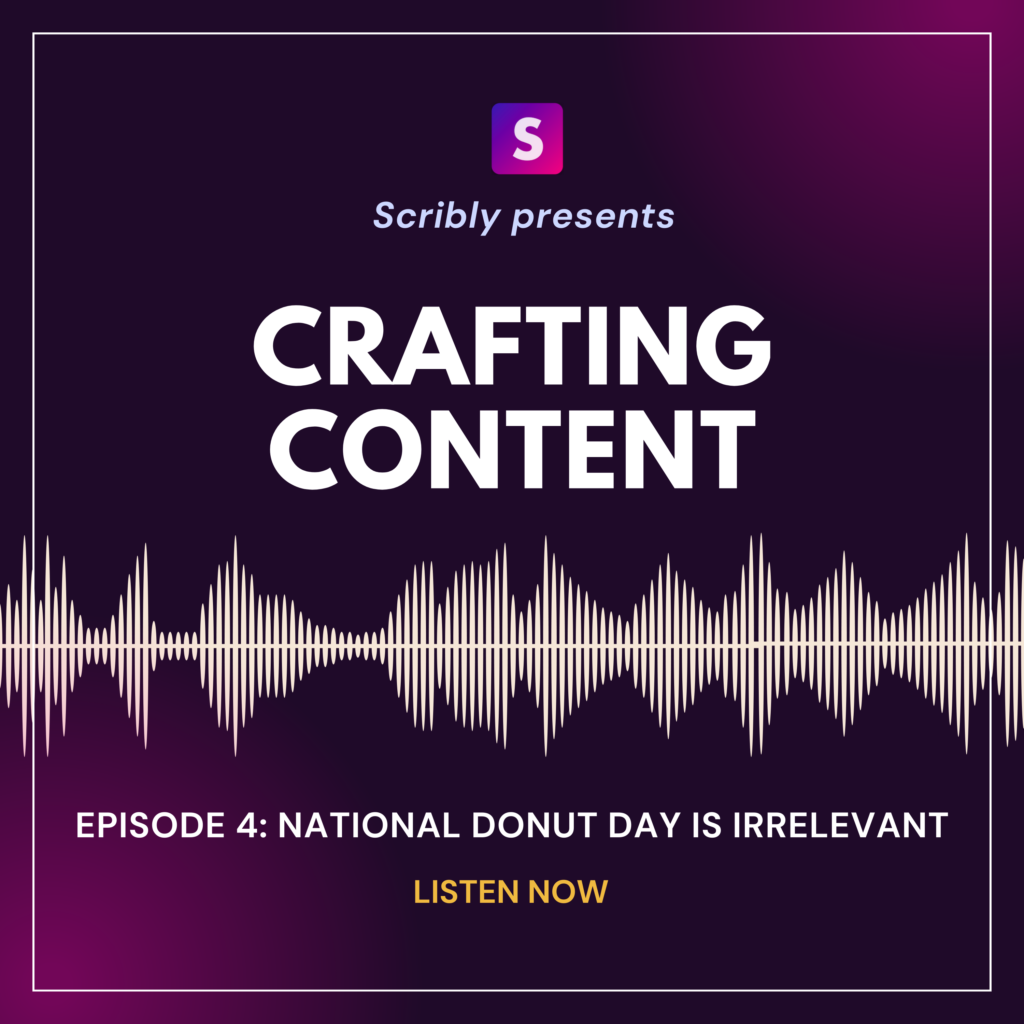Crafting Content – A content marketing podcast from Scribly
Crafting Content episode 4: National Donut Day is irrelevant
The fourth episode of Scribly’s “Crafting Content” podcast is here! We share insights, top tips, and real-world examples to help you develop your content marketing skills in this new content marketing podcast.
Continuing on our “common content marketing mistakes” mini-series, today’s topic is about irrelevant content. We discuss what irrelevant content is, how to identify it, and how to optimize it. Most importantly, we offer advice on how to identify relevant content topics that your audience wants to engage with, so you can create more helpful content in the future.

You can listen to the full episode here: Scribly’s Content Marketing Podcast Epsiode 4: National Donut Day is irrelevant
Episode 4: National Donut Day is irrelevant (transcript)
Taylor: Welcome back to Crafting Content, the Scribly podcast. We are still talking about common content marketing mistakes that we see maybe not every day, but quite frequently, and how you can avoid making those mistakes when creating your own content. I’m Taylor and with me is Elle. So, what are we talking about this time?
Elle: We’ll be covering what we call “irrelevant content”. What we mean by that is any content that doesn’t interest your users, that they’re not going to relate to, or that you don’t have the authority to talk about. I think one of the most common times that we see this is on a day like National Donut Day. So a company publishes something about donuts, even though they don’t sell donuts.
Taylor: They sell software.
Elle: Yeah, exactly. So, that’s what we mean by “irrelevant content”. Or, it might be that it’s relevant to your brand but you’re not the right person to be talking about the topic. Say, you sell software but specialize in mobile software and you want to publish something about desktop software but can’t have a guest contributor or someone else with the authority to speak about that, then you don’t want to be creating that content either.
Taylor: Makes sense.
Elle: I noticed you giggled a little bit when I spoke about jumping on trends and national days. From your perspective, when do you most see brands create irrelevant content?
Taylor: I think it’s those moments, like you mentioned, where there’s either a national whatever day which is outside of the realm of your industry and the types of products or services that you sell, or there’s a greater trend in business in general that people hear about and they’re like “oh, well, we have to be writing about this because we are also a business and so we must keep up with business trends”.
One of those things that I think is a really big one right now is AI. Every business, no matter what they do, wants to write or talk about AI. Understandable, it’s the talk of the town. But if you don’t sell a tech product, or you don’t incorporate AI into your offerings, or you’re not in an industry that’s being affected by AI, that’s not really going to be relevant to your readers, and they’re not going to see your take on AI as authoritative.
Elle: Yeah. So, I guess what you’re saying is, when you’re creating irrelevant content, one of the dangers is that it’s not going to resonate with people, or people aren’t going to see the value in your voice across that topic. Are there any other dangers or consequences that brands should be aware of?
Taylor: Well, I think that it has the potential to put people off of your brand. It’s the know-it-all factor a little bit. You come to a page expecting to learn about a certain thing or to read discussions about a topic that’s related to the brand and then it’s something totally different. And maybe they don’t necessarily know what they’re talking about and so it can be a little off-putting—like “I don’t really understand why you’re talking about this thing. So, I don’t really trust what you have to say about anything else” which you don’t want. You want to keep people on your site and interested in your brand and products and what you have to say as much as possible. So you want to keep things relevant.
Elle: So I guess that leads quite nicely into talking about relevant content versus irrelevant content. If you’re a brand, it’s quite easy to say “Okay, I don’t sell donuts. I’m not going to talk about donut day”. But a lot of the time, it runs a lot more deep than that because it might just be irrelevant for their user. So, it’s relevant to the industry in which they work, but it’s not relevant to the demographic or location of their audience. How would a brand identify that certain content topics or content pieces aren’t relevant to their audience?
Taylor: One of the best ways to do that is to look at how your content is performing. You want to see if people are finding your content but not necessarily reading it or engaging with it in-depth.
Some of the things that you can look at are how much time people spend on the page in question and the bounce rate. If it’s high, then it’s not getting the desired effect. Another thing you can look at is the overall trend of your traffic. If that’s going down, that could indicate that your content isn’t relevant. There’s a statistic that over 40% of people disengage with brands that share irrelevant content.
Elle: Wow, that’s a lot of people.
Taylor: It’s a lot of people—like nearly half of all the people. So, you don’t want that to happen. If you start to see that overall you’re not getting as much traffic, that could indicate that you need to look at what you’re creating and if the people you’re trying to reach are even interested in that content.
And then you can look at engagement. If you have low engagement across certain kinds of content—say low click-through rates on your emails, or not many likes or comments or shares on social media posts—that could indicate that your audience doesn’t want to read about these things from you specifically. Those are some of the ways that you can pinpoint irrelevant content from a technical point of view.
Elle: Okay, so a brand would go in, audit their website, look at bounce rate, time on page, traffic trends, and engagement across their other content platforms. Let’s say a brand identifies which content their audience isn’t enjoying reading or isn’t engaging with. How should a brand go about “fixing” that irrelevant content? What do they do with the content they’ve identified as irrelevant and hhow do they make sure that they’re not producing irrelevant content in the future?
Taylor: So, to the first point, you want to take stock of the irrelevant content in question and decide if there are any redeeming qualities here. Is there anything in here that could potentially be relevant?
If the answer is “no”, you probably want to delete it altogether because it’s just going to do the opposite of what you want it to do. If the answer is “maybe” or “yes”, then you have some other options.
You could rewrite or update that content to be more relevant to your brand. So, find a different point of view or a different approach to it that makes more sense and aligns better with the rest of what you’re trying to say. Beyond rewriting a piece of content or drastically updating it, are there any other things that, people can do to help deal with irrelevant content?
Elle: If you don’t want it to affect your SEO, but you’d still want it on your site for whatever reason you could make it “no index” which basically means that Google’s bots won’t crawl that page and they won’t show it to people on search results. So, the likelihood is that fewer people are going to find it. As such, it’s not going to create that ick factor with your users or confuse them about why you’re talking about this topic because they’re unlikely to find it.
Or, another option is to simply not share it, not promote it. We talk a lot in content marketing about how all the different content channels work together. So, if you produce a blog post, you want to push it through a newsletter, share it on social media, link to it from your website homepage, or from a relevant FAQ page on your website. Instead, you could hide it in the depths of your site.
Tayloe: Brush it under the rug. The internet rug.
And then in terms of creating content that is definitely relevant, the key there is really knowing your audience, who you’re trying to speak to, and what they want to hear. The best way to do that is to figure out who your audience is, who your customers are, what they need. The more you can learn about them, the better you can tailor your content strategy to them, the more relevant your content will be to them.
Elle: Yeah, I think that’s a really interesting point, because we come across such a large number of clients who have no real idea of who they are targeting. I once worked with a Vitamins brand, and they basically said,”we’re targeting people”. No, “these products are best for women because of XYZ”, or for women during pregnancy, or for women over this age. They didn’t even know which product would perform best. They had an age restriction of no one under six. They basically said, anyone over six is who we’re targeting.
Taylor: And I’m like, well, it’s a lot of people.
Elle: Exactly. Knowing who your audience is 1) something that brands too often overlook, and 2) is really important in terms of making sure that your content is relevant to that audience.
Taylor: That can seem like a big thing to approach if you’re just thinking about “who’s my audience?” from a marketing content perspective. But if you’re a brand, you already know who your customers are to a certain extent. You know what your product or service offers, who generally will be using that, or will be more inclined to use that. If you can start from there and then just understand what kind of content they consume and where they interact with content, that alone can just be a great first step to figuring out where you need to start to create stuff that’s relevant to them.
Elle: That’s a great tip. A lot of brands are definitely intimidated by building out their marketing personas.
Taylor: It doesn’t have to be super hard. Just start with what you know and then go from there and then you’ll be creating relevant content and we won’t be worried about people writing about National Donut Day when they really shouldn’t. so that is one more mistake solved. We’re doing such good work here, so we will be back again in, a future episode with another content marketing mistake that we encounter and we look forward to seeing you there.
Thank you for listening to Crafting Content, a content marketing podcast from Scribly. You can find more information about what we cover today in our show notes.
Scribly is a content marketing agency that helps you boost traffic, generate sales, and increase your bottom line. With our end-to-end service, we take care of everything from content audits and strategy to content creation and management across websites, blogs, socials, and email. We’re a small but mighty team of experienced strategists and marketers who specialize in content creation. If you want to learn more about how Scribly can help your business, please get in touch. You can find more information and send us a message on our website. We’d love to hear from you!
But if we’re talking purely about the copy side of things—just to limit the breadth of what we’re going to talk about—one of the biggest topics to discuss is keywords.
In our last episode, we chatted about people micro-focusing on different elements of SEO. They’ll know that to create content, you need to focus on a keyword. So, they’ll go out and choose a keyword without considering the intent behind that keyword, the type of content that fits with that keyword, or if anyone’s even searching for that keyword. Then, they’ll just put it in the piece and use it too often or not in a natural way—and then they’re confused as to why their content isn’t performing.
There’s this misconception about what keywords do, how to use them, and how to choose them effectively.
Taylor: Do you think that people pick keywords that have too low a search volume, or do they tend to go for keywords that are too difficult to rank for?
Elle: If they’re doing the keyword research—because that’s another thing; a lot of people pick a keyword without actually checking the search volume or difficulty.
This again comes down to a misconception of what content marketing is. There’s this idea that we’re all just sitting in a room, brainstorming ideas about what blogs we’re going to write, and then we go out and write them based on those ideas. So, businesses replicate that false scenario.
They’ll come up with an angle to talk about a topic where they’ll use a phrase that comes naturally to them, but might not necessarily be the phrase that people are using to talk about that topic.
We’ve called this podcast “crafting content”. You might write a blog post that uses the key phrase “how to craft high-quality content”, but no one’s actually searching for that phrase. Instead, they’re going to use an expression like “how to write great content” or “how to write quality content” or “how to write good content”, et cetera.
Taylor: Or maybe the word “content” isn’t in that search query at all. The keyphrase refers to a specific type of content, like a blog, say “how to write a great blog post”.
Elle: Yeah, which you’d only know if you’ve done the keyword research.
So, there’s that side of things. Then on the flip side, you’ve got those who are doing keyword research but don’t necessarily know what to do with the information or what the data is telling them.
Let’s say they discover that “how to write a blog” has a really high search volume and they’re thinking “winner, I’m onto something”, but actually it’s got a competitiveness of 80, which is huge. (Competitiveness is marked on a scale of 1 to 100, so anything getting into that 80 mark is pretty darn hard to rank for).
And so they’re choosing that because it’s got a high search volume, despite the fact that it’s got a competition that they’re never going to be able to compete with.
Taylor: Okay, so you want to use keywords with the right balance between competitiveness and search volume. You have to find that balance. What other sorts of keyword mistakes do we see often?
Elle: Two things. The first is considering the intent, but I’ll come back to that one. The other is the type of keyword. These two do go hand in hand, but, let’s take your “how to write a blog” example again. How to write a blog is quite a long keyword. In fact, “key word” is probably the wrong term for it, right? It’s a key query, or key question, or key phrase, whatever you want to call it.
But someone might choose to search for the phrase “blog”. That keyword is going to have an incredibly high search volume, right? The person who’s searching for the term blog: 1) will probably then have to do another search because the results they’re going to get aren’t actually going to show them what they’re looking for, and 2) they might not be looking for tips on how to write a blog but are actually looking for a blog about something.
“Blog” is such a broad term. You could be looking to read a blog, write a blog, finding blogging software, etc. So, if you’re targeting the keyword “blog” in an article about “how to write a blog”, but the type of people who are actually searching for the word “blog” are looking to read a blog about pet food, then your blog isn’t meeting their needs.
It’s about aligning the intent behind the keyword with the content that you’re offering and usually reverse engineer that. Let’s say a user is searching for “dog food” or “dog toy” or whatever. Those are very short-tail, commercial, and transactional-driven keywords. If someone’s searching for “dog food” or “buy dog food”, then they’re ready to make a purchase. So, they’re likely looking to find a product page, category page, or website that sells food.
Whereas, if they search for a longer tail keyword, like “best pet food for rottweilers”, or “why should I feed raw food to my dog?”, or “benefits of organic food for dogs”, then their looking to learn. To answer their questions, a business that offers dog food would produce a blog explaining and answering those queries.
So, I think the first biggest mistake is using the wrong type of content to go after either long tail or short tail keywords. The second is not aligning the content that you’re creating with the intent behind each of those keywords.
Taylor: That makes sense. The other thing to consider with SEO is how you use those keywords. We’ve touched a little bit about over stuffing—with particularly short tail keywords.
You can build out a piece with those longer tail keywords using the queries as headings but an important element that people overlook is structure and quality (which we talked about in a previous episode—you might want to go back and listen to the discussion we had about creating high-quality content).
It’s so important and so intertwined with SEO when we talk about having headers that structure the article, using bullet points, or images, or videos, or other content that makes it much more readable, and having “technical” content with optimized metadata and alt text in your images.
It might even come down to making sure that your content is updated regularly and that you’re providing readers with the latest information. So, if you wrote a blog piece about why organic dog food is best, there might be a new piece of research that comes out that you might want to add into that article.
Or, if you’re doing a “best organic food for dogs” blog and one product is no longer on sale, you might want to go back and update that content and remove that product.
Taylor: So all of those elements contribute to showing Google that you are an authority within your space, that you’re creating valuable content, all of which falls into the crazy algorithm that they use to decide whether or not your content ticks their SEO criteria.
So if a company has a blog—let’s focus on blogs in particular here just to simplify things—and they don’t have particularly well-structured blog posts, what do you do to fix it? Do you have to start over or can you change things incrementally? Will that make a difference?
Elle: Yeah, it’s a good question because it really depends on what your starting point is. Let’s assume that the quality is there. So, the information is correct, there’s enough content there, but it’s written like a magazine, right? Essentially, they’ve written it well but it’s not optimized for online comsumption. It doesn’t have an SEO element. In that case, absolutely, you can use that as a starting point.
What’s likely to happen is the structure needs amending. If you read a magazine article, typically they tend to be pretty flowy. There are no headers because they’re not needed in printed format. To adjust the content for an online audience, you might group ideas together to turn them into sections that can then have structured and optimized headers. You might include the keyword, naturally within the introduction.It might be that one small section could actually be turned into a bullet point list. As long as you’ve got the information there, it’s more about how we then turn that into content which is going to be digestible online and work that keyword research into it. We need to make sure that we’ve got that structure and quality that we’re looking for.
Then, we’d also look at internal linking, which again, you wouldn’t have in printed copy, but is so important from an SEO perspective. When you’ve got a link on a page, it signals to Google a passing of authority between pages. You can use that within your own website. Now obviously it doesn’t have as much value as someone external linking to your site because you’re saying “I’m an expert on this thing that I’m talking about” but you’re still guiding the user to relevant content.
Say you’re writing a blog piece about a given topic. In a pillar blog, you might cover a sub-topic in a small paragraph and link to a child blog that is dedicated to that topic. You’re essentially telling readers “hey, read more here or find out more here”. Or, if it’s a blog about “the X best products”, you might link directly to a product page.
All these elements are going to help pass on link juice, but also create a better user experience, which again is another SEO factor that fits into this monster of an algorithm.
Taylor: But you shouldn’t just be linking to your own stuff? You can and should link internally, right? But you also want to link to other places on the internet. How should people be approaching external links specifically?
Elle: It’s just about choosing the right link and the right source. One of the most common edits you and I probably make when it comes to articles, is when people put in a statistic they found in an article called “50 statistics about X” and it doesn’t actually give you the original source. If you’re linking to something like that—which isn’t very trustworthy—you might want to go into an SEO tool and check the site authority of that source. Ideally, though, you want to select websites which are viewed as an authority by Google so that you’re giving that trust signal to search engines of “my source is someone that’s trustworthy, therefore I am trustworthy as well”. Rather than linking to Wikipedia, you might link to a new study in an online university research paper, or whatever. It’s just making sure that we’re choosing relevant sites.
Taylor: Or, in the case of statistics, instead of linking to the 50 best statistics about remote work, you might link back to the McKinsey study about changing methods of work or to the Office of National Statistics in the UK which has a remote work study that came out earlier this year. You want to find things that are like clearly put together by legitimate organizations with some clout behind them, not like Bob in the basement, putting together a list of statistics.
Elle: Exactly. Plus, a trustworthy source — say the Office of Statistics—they will host that report online forever, which usually means that the external link on your site that points to their report won’t end up becoming a broken link. Whereas any other non-trustworthy, non-authoritative site, might take their page down and then you’re left with a broken link on your website, which is going to affect your SEO.
It’s worth thinking about the long-term benefits of choosing the right source.
Taylor: SEO has a lot of elements to it that you need to consider, which we have just only mentioned a very few of. It can be quite hard to try to figure out all those elements and see how they fit together and help or hurt each other without knowing what you’re doing because it’s quite overwhelming. It’s like a lot of stuff to deal with.
Elle: That’s what our clients struggle with as well as. They’re like, well, but what about this? And what about this? They need to learn. I think that’s why it’s so important to work with an agency who knows what they’re doing. They can provide that guidance and provide that education to help you understand enough to be able to know the logic of what they’re doing and then having a partner that will be able to meet all of those SEO needs.
Taylor: That is why you shouldn’t ignore SEO when you’re creating content. We’ve got plenty more content marketing mistakes to cover. So, we’re goning to stop there for this episode and come back with another mistake in the next episode. We will see you there. See you then!
Thank you for listening to Crafting Content, a content marketing podcast from Scribly. You can find more information about what we covered today in our show notes. Scribly is a content marketing agency that helps you boost traffic, generate sales, and increase your bottom line. With our end-to-end service, we take care of everything from content audits and strategy to content creation and management across websites, blogs, socials, and email.
We’re a small but mighty team of experienced strategists and marketers who specialize in content. If you want to learn more about how Scribly can help your business, please get in touch. You can find more information and send us a message on our website. We’d love to hear from you!




